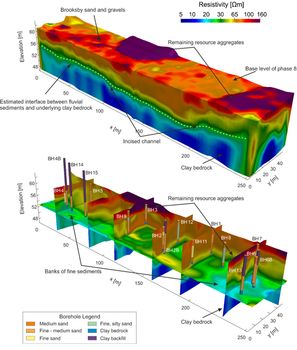Brooksby Quarry: Investigations of the incised channel
University of Leicester Archaeological Services, Research Laboratory for Archaeology & History of Art, Royal Holloway, University of London, British Geological Survey, 2019. https://doi.org/10.5284/1052202. How to cite using this DOI
Data copyright © University of Leicester Archaeological Services, Research Laboratory for Archaeology & History of Art, Royal Holloway, University of London, British Geological Survey unless otherwise stated
This work is licensed under a Creative Commons Attribution 4.0 International License.
Primary contact
University of Leicester Archaeological Services
School of Archaeology and Ancient History
University Road
Leicester
LE1 7RH
Resource identifiers
- ADS Collection: 3356
- DOI:https://doi.org/10.5284/1052202
- How to cite using this DOI
Introduction

A series of linked investigations have been carried out to further the understanding of the character of a distinct deposit of sands and gravels identified near to Brooksby, Leicestershire, the Brooksby Sand and Gravel. These deposits infill a bedrock incised channel of the Bytham river, a major Pleistocene river system that drained the English Midlands prior to the Anglian Glaciation (Marine Oxygen Isotope Stage [MIS] 12). The deposits which lie between 55m and 60m aOD, are thought to have accumulated during a period of temperate conditions within the Cromerian Complex, a period of the earliest hominin activity in Britain.
A multidisciplinary approach commissioned by English Heritage as part of the Development Area Pleistocene Projects (3A3.202) programme, included investigations by University of Leicester Archaeological Services, British Geological Survey, Royal Holloway University of London, the Research Laboratory for Archaeology & the History of Art, University of Oxford, and independent specialists.
The investigations were carried out between April 2013 and November 2014 and included Electro Resistance Tomography (ERT) survey, borehole drilling (shell/auger and sonic), archaeological trenching, palaeoenvironmental sampling and Optically Stimulated Luminescence (OSL) dating sampling.
The results have created ERT model(s) displaying the results and the incised channel of the Bytham River. Quartzite artefacts and environmental material including some pollen, small vertebrate remains, wood and plant macrofossils were recovered/ sampled from the investigations. The finds and documentary archive will be deposited with Leicestershire Museums under the accession number XA57.2006.








